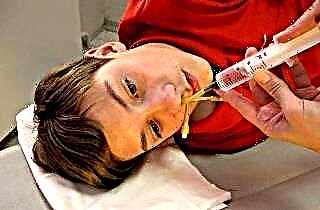Allergy is called "the disease of civilization", "the plague of the XXI century" - if you look at the indicators of the frequency of occurrence of allergic diseases, these statements seem more than reasonable. Allergy proceeds in different ways and takes different forms; the appearance after numerous studies of the term "allergic inflammation" has significantly expanded the range of ideas about it. What is allergic pharyngitis, what symptoms characterize this pathology in adults and children? A patient who is faced with a similar disease should know not only about the clinical signs, but also about the methods of treatment that can be recommended by the doctor.
Pharyngitis as a respiratory allergy
 Sore throat, combined with irritation of the mucous membrane and periodic coughing, are symptoms that allow one to suspect that the patient has an inflammatory process in the pharyngeal region, that is, pharyngitis. Why does this disease occur? Usually, infectious agents - viruses, bacteria, pathogenic fungi - become provocateurs. However, there are also non-infectious forms - in particular, allergic pharyngitis.
Sore throat, combined with irritation of the mucous membrane and periodic coughing, are symptoms that allow one to suspect that the patient has an inflammatory process in the pharyngeal region, that is, pharyngitis. Why does this disease occur? Usually, infectious agents - viruses, bacteria, pathogenic fungi - become provocateurs. However, there are also non-infectious forms - in particular, allergic pharyngitis.
Inflammation of the pharynx of an allergic nature is classified as a respiratory allergy, or rather, its small form. Respiratory allergies are understood as all allergic diseases of the respiratory system, including allergic rhinitis and bronchial asthma. Allergic pharyngitis can have a course of:
- isolated;
- combined.
Isolated forms of allergic lesions of the pharynx are extremely rare. The classic option is the combination of pharyngitis with allergic rhinitis, laryngitis, sinusitis, otitis media.
Allergic pharyngitis occurs as a result of exposure to a trigger, or provoking factor - an allergen. There may be one causal allergen, however, in the vast majority of cases, patients are sensitive to many provocateurs, and allergic reactions can be cross-linked, which significantly expands the range of probable triggers. Allergens enter the body:
- by inhalation;
- when eating food.
Since the pharynx belongs to both the respiratory and the digestive system, its mucous membrane is in contact with various irritants, including allergens. In this case, the most important factor is not the amount, but the structure of the substance with which the contact surface is in contact, as well as the presence of allergic inflammation in the pharyngeal region, individual sensitivity.
There is an acute and chronic or recurrent form of allergic pharyngitis. Relapses, that is, repeated episodes of the disease, occur with each repeated contact with the allergen. If the impact of provoking factors does not stop or recurs very often, the pathological process becomes chronic. The site of localization of allergic inflammation is not always limited to the area of the pharynx and can expand (pharyngolaryngitis, pharyngolaryngotracheitis and bronchitis develop).
Symptoms
How does allergic pharyngitis manifest itself - do the symptoms appear suddenly or are there signs that precede their appearance? Unlike infectious diseases, in the development of which incubation and prodromal periods are distinguished, respiratory allergies are characterized by an acute onset and a rapid increase in the severity of pathological signs. The severity of manifestations can depend on many factors, in particular, on the age of the patient.
With an isolated form of the disease, patients are worried about:
- difficulty swallowing;
- sore throat, often felt as mild soreness;
- sensation of irritation, tingling, itching in the throat;
- dryness of the pharyngeal mucosa;
- coughing, sometimes with a small amount of mucus.
Allergic pharyngitis is characterized by the so-called pharyngeal cough - an obsessive, unproductive (or unproductive) cough.
Symptoms of inflammation of the pharynx may be accompanied by signs of disturbances from the nose, ears, larynx, trachea, bronchi. In this case, it additionally occurs:
- Cough.
Patients describe it as paroxysmal, extremely painful and intrusive. The cough is unproductive; phlegm is not released during cough tremors, sometimes a meager amount of mucus is coughing up.
- Runny nose.
It is accompanied by severe swelling and itching of the nasal mucosa, difficulty in nasal breathing, sneezing, and deterioration of smell. The discharge is profuse, watery and / or slimy. Patients often rub their nose, the skin above the upper lip and at the wings of the nose is irritated, reddens; with frequent blowing of the nose, nosebleeds may occur.
- Pain, crackling in the ears, hearing impairment.

Symptoms intensify at the time of swallowing, occur as manifestations of allergic tubo-otitis and often accompany allergic pharyngitis, combined with allergic rhinitis.
The manifestations of the disease intensify at night, as well as as a result of contact with an allergen. They appear within a short time after contact with the provocateur, but with proper elimination therapy and complete removal of the allergen, they do not recur until a new contact. When examining the mucous membrane of the pharynx, attention is drawn to edema, sometimes redness, the presence of mucous secretions. With allergic pharyngitis, there are no purulent layers or plugs.
Manifestations in children
When describing the symptoms of allergic inflammation of the pharynx, it is worth talking separately about the signs of the disease in children of the younger age group - the clinical picture in older children coincides with the characteristics of manifestations in adult patients.
Symptoms in a young child are acute and include:
- dry obsessive cough;
- irritation and itching in the throat;
- swelling, itching of the nose and runny nose;
- sniffing, voice change;
- increased body temperature.
 In young children, allergic pharyngitis is usually combined with rhinitis, so the symptoms of these diseases are combined. With a pronounced runny nose, the child breathes through the mouth, snores and sniffs during sleep. Atypical symptoms include weakness, sweating, and drooling. With concomitant allergic lesions of the lower respiratory tract, children sometimes cough so hard that their face turns red, vomiting appears. There is a risk of edema not only of the mucous membrane of the pharynx, but also of the larynx; development of urticaria is possible.
In young children, allergic pharyngitis is usually combined with rhinitis, so the symptoms of these diseases are combined. With a pronounced runny nose, the child breathes through the mouth, snores and sniffs during sleep. Atypical symptoms include weakness, sweating, and drooling. With concomitant allergic lesions of the lower respiratory tract, children sometimes cough so hard that their face turns red, vomiting appears. There is a risk of edema not only of the mucous membrane of the pharynx, but also of the larynx; development of urticaria is possible.
Principles of therapy
How is allergic pharyngitis treated? For both adults and children, the following principles of therapy are relevant:
- Termination and avoidance of contact with allergens.
- Improvement of microclimate parameters, elimination of “risk group” allergens.
- Education of the patient and his immediate environment.
- Allergen-specific immunotherapy (ASIT), pharmacological agents.
Allergies in any form cannot be cured until the provoking factors are eliminated. Otherwise, even the best medicines can only stop the symptoms and are not able to prevent possible complications.
To remove allergens, you need to know which substances are causing the reaction - for this, a food diary is kept, a laboratory test is carried out.
Animal hair, house dust, bird feathers as a pillow filler, household detergents, and a variety of cosmetics are likely allergens. Even if a child or adult is insensitive to them, this can change. It is worth checking with the attending physician what irritants should be feared ("risk group"), and remove them completely.You should also regularly carry out wet cleaning, ventilate the room where the patient is (in his absence). It is better to abandon fleecy carpets, minimize the number of soft toys, optimize the microclimate (humidity, temperature) in the room, adhere to a hypoallergenic diet.
The patient should be aware of how an allergy differs from an infection, what measures can be taken to avoid recurrence of symptoms. Explaining the danger of allergens is necessary not only for the patient (even if he is a child), but also for those people who are near him: parents, close relatives. A kindergarten teacher and school teacher should be aware of allergy tendencies.
ASIT, pharmacotherapy
Allergen-specific immunotherapy has clear indications and contraindications, is carried out by a specialized specialist and allows you to reduce sensitivity to the allergen (to form tolerance). This is not a symptomatic, but a pathogenetic treatment that can change the body's response to an allergen. It is carried out in courses by introducing an extract of a causal allergen, it is not performed during an exacerbation of an allergic disease, for children under 5 years old.
Pharmacotherapy of allergic pharyngitis in adults and children includes:
- antihistamines (Cetirizine, Desloratadine, Claritin);
- blockers of leukotriene receptors (Montelukast, Singular);
- intranasal glucocorticosteroids (Fliksonase, Nasonex);
- intranasal cromones (Cromohexal);
- decongestants (Tizin, Otrivin).
The treatment regimen for allergic pharyngitis depends on the combination with other respiratory allergies, as well as on the severity of the course. So, with significant swelling of the mucous membrane, impaired nasal breathing, decongestants, antihistamines can be used. If the manifestations of pharyngitis are difficult to stop with these agents, the question of the use of topical (local) glucocorticosteroids is considered. The selection of the treatment regimen is carried out by the doctor individually.
The drugs are available in the form of tablets, syrups, sprays, and nose drops. It should not be forgotten that throat sprays cannot be used until the child reaches the age of 5 years due to the risk of laryngospasm. When choosing drugs for children, age restrictions apply: for example, some antihistamines are allowed as early as 6 months (Cetirizine, Zyrtec), while others (Ebastin, Telfast) are only allowed for patients over 6 years old.
Decongestants, or vasoconstrictor drugs, are used to reduce swelling of the nasal mucosa and upper pharynx (nasopharynx), and are used with extreme caution in children. Like other medicines, they are prescribed only by a doctor. If used improperly, overdose symptoms develop, which are more dangerous, the younger the child.




